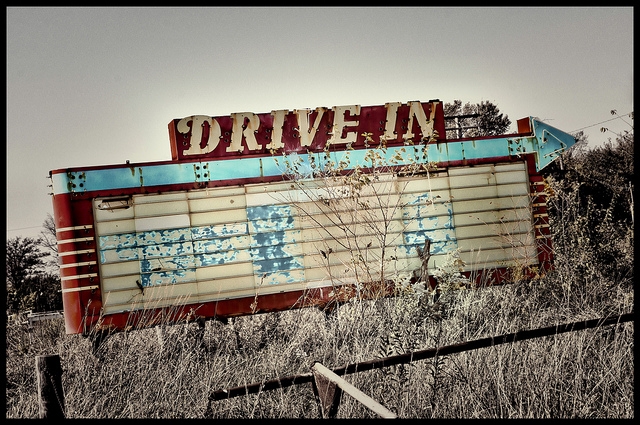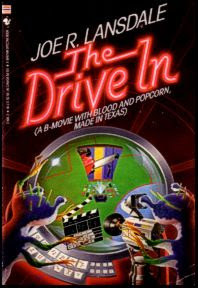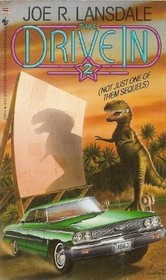Review: The Drive-In

A generation or two ago, Texas was known for its sprawling drive-in cinemas and zany monster flicks playing out over the cool summer air. In his 1988 cult classic, Joe Lansdale taps into this nostalgia, turning a lightsome night out at the theater into a grungy galleria of claustrophobic terror. What begins with frights and screams beaming from the sparkling screens ends with panic-stricken mobs dancing to the tune of the B-movie gods. Jack and his three friends dash off to the movies, only to become part of one themselves — an insidious twist ensued by barrels of laughs, irreverence, and a vomitorium of blood-encrusted popcorn.
A two-shot pulse of comedy and horror, The Drive-In is a goretastic romp through B-movie stardom. Four teenage friends and the moviegoing locals are ejected into the front row of their very own apocalypse. Basic camaraderie is among the first to go as normalcy takes a back seat to survival. Engulfed on all sides by an ink-like substance that promises sure death, the crowd is barred from leaving the drive-in. They have for food and drink whatever remains of the concession supply, and only the looping movies and each other for company. The forces interacting from the outside manifest themselves in mysterious ways, slowly but surely driving the trapped masses to bedlam. The face of humanity slips away as if being sucked into the murk beyond, unmasking an anarchic depravity unseen this side of hell.
Lansdale paints a vivid world wrapped in a narrative economy that allows for just the right mix of action and character progression. In Stephen King’s hands, this might have ballooned to 350+ pages, but Lansdale’s tight writing forbids any eyes from glazing over. Keeping the chaos front and center puts the reader permanently on edge, while the author’s extraterrestrial imagination makes for an unpredictable tale. Around every corner lies a gruesome conflagration or another fantastic one-liner, oftentimes both.
The characters are witty, but not as witty as Lansdale, who reserves the maximal comedic payout for himself. His deadpan descriptions always hit home and blend seamlessly into the unfolding horror. An early scene places the characters in a bar, and a dustup with a patron is foreshadowed thusly:
The vibrant interplay between humor and horror is mostly successful, even if many of the sequences are about as over the top as it gets. Cannibalism? Check. Crucifixions? Check. Sacrilege? Check. One scene features a group of Christian evangelists using their faith as a cover for their cannibalistic jonesing, a swivel rightly qualifying as the nadir of religious experiences. The squeamish and easily offended might look for their fiction fix elsewhere, though the violence is never handled too seriously.
There also seems to be a whole social satire subtext in which the main character spends ample time existentializing amid the bouts of receding humanity arrayed before him. The rollicking lunacy of it all only adds to the absurd juxtaposition of deep cogitation on things philosophical. Nevertheless, what the narrative seems to be getting at is that for all our pretensions to civility and higher consciousness, the only thing keeping us from reverting to the behaviors of the wild is the distance from our last meal. The collapse of society is only a hunger pang away.
But don’t waste your time trying to find morals or life lessons embedded here. The Drive-In: A B-Movie with Blood and Popcorn, Made in Texas is raunchy-rowdy fun and a perfect alternative to a night at the movies. It’s graphic and gritty in all the right ways and serves as a dark warning to humans everywhere: Grow too peaceable, and the gods get bored.
The Drive-In 2
The sequel, fittingly titled The Drive-In 2: Not Just One of Them Sequels and released a year later in 1989, unfortunately does not live up to its predecessor. Here Lansdale spends much of the time recounting the events of the first novel through the perspective of other characters. These backstories are rambling affairs which drag on entirely too long and pale in comparison to the raw immediacy of the original.
Nor do the new characters and villains do justice to the unique cast crafted in book one. Grace is less dimensional than the teenage wet dream to which she clearly owes her origins, while Popalong Cassidy is a catch-all antihero conceived on LSD and put to print on ritalin. And contrary to the book’s cover, dinosaurs do not number among the hazards in this phantasmal caper. (I wouldn’t be surprised if Lansdale edited out the reptilian bits after it was too late to change the cover art.)
Moreover, the writing isn’t nearly as solid, the narrative as focused, the sequences as memorably scripted, or the comedy as chuckle-inducing. Whereas the first book’s laughs and vulgarity were well-placed and right on pitch, the raunchiness of the sequel is spread like chipped paint, awash in overspent shock value and bargain-bin clichés. Lansdale either ran out of steam on this one or all but phoned it in. The tension just isn’t there, and the ride isn’t as fun.
The idea of society-as-cinema felt fresh and thrilling in Lansdale’s first outing but fails to breathe enough new life in the second take to keep me coming back for more. While it’s even higher on the wonkiness scale than the original, its disordered pastiche of influences and repetitive nature ultimately terminate in forgettable schlock — like a B-movie you really didn’t need to see.
Note: This review is mirrored over at Goodreads (original, sequel) and at Amazon (original, sequel).




Comments